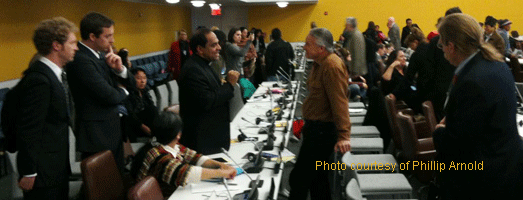 Monsignor Dr. Kuriakose Bharanikulangara
(Vatican representative) and Steve Newcomb at the 9th Session of the U.N.
Permanent Forum on Indigenous Issues, NYC (April 2010)
Monsignor Dr. Kuriakose Bharanikulangara
(Vatican representative) and Steve Newcomb at the 9th Session of the U.N.
Permanent Forum on Indigenous Issues, NYC (April 2010)Steven Newcomb shares the colonial roots of the United Nations Declaration on the Rights of Indigenous Peoples:
When people these days discuss the United Nations (UN) Declaration on the Rights of Indigenous Peoples, they have no idea that 70 years ago, just before the end of World War II, such a document was already being envisioned. What was being focused on back then, however, was the “colonial problem,” which was a subject of discussion for the U.S. government and for the United Nations at that time. One scholar envisioned a “Charter of Colonial Freedom” as a proposed solution regarding “colonial” or “indigenous” peoples. In 1943, the Institute of Pacific Relations in New York published Dr. Laura Thompson’s “Steps Toward Colonial Freedom: Some Long-Range Planning Principles for a Peaceful World Order.” Dr. Thompson was a psychologist based at the University of Chicago, and she wrote the essay while working for the U.S. Navy. Given the title of the paper, one realizes that the elite at that time did not envision ending colonialism. Instead, they foresaw the need for certain approved “principles” under colonialism, or a version of “freedom” that Thompson termed “Colonial Freedom.” Comparably, today the U.S. government is fond of saying that the text of the UN Declaration on the Rights of Indigenous Peoples is just “a set of principles” which are aspirations. That’s state-speak for: “The Declaration recognizes you as having the right to ‘aspire’ to someday achieve certain rights for yourselves, in the future.”Get the Story:
Steven Newcomb: Toward a Future of Colonial Freedom (Indian Country Today 5/14) Related Stories:
Steven Newcomb: Vatican remains in denial about colonization (5/5)
Join the Conversation